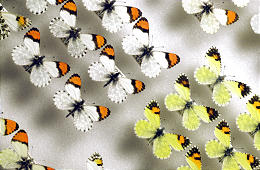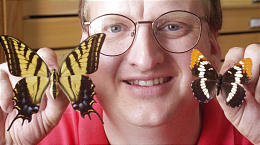

Monday, September 10, 2001
 
|
Monday, September 10, 2001 |
By Joe
Bauman
Deseret News staff writer
When
Todd Stout was about 7 years old, walking home after school in Glendale, Calif.,
he noticed black-and-yellow butterflies gathering nectar from flowers. He caught
one, took it home and put it in a jar — but he was caught himself.
E-MAIL: bau@desnews.com
"I was just fascinated," says Stout,
who now knows the butterflies were western tiger swallowtails.

Sara
orange tip butterflies make a stunning display. The Lepidopterists Society
encourages collecting for scientific purposes.
![]()
Jeffrey
D. Allred, Deseret News
He borrowed a 1927 butterfly book from the local
library, studied it, discovered how to mount the insects and learned everything
he could about butterflies. His mother made a butterfly net, and soon his hobby
attracted the attention of other children in the neighborhood.
"Six or seven boys got their moms to sew
butterfly nets. Then we would kind of all collect butterflies together on my
block," he said.
Today he is married and living in the Northpoint
section of Salt Lake County. But he is just as fascinated as he was when he was
a boy.
Stout is president of the Utah Lepidopterists
Society, a group with about 30 members. They meet on the second Saturday of nine
months in the year to discuss the science and lore of butterflies and moths.
Their gatherings alternate between the Utah
Museum of Natural History at the University of Utah and the Monte L. Bean Life
Science Museum at Brigham Young University, Provo.
But they don't meet during the summer, Stout said
during an interview at his home. June, July and August are the busy months,
"when people are out catching butterflies."
The 2001 butterfly season is over for the most
part, although some butterflies are still around. "There's always cabbage
whites until the freeze," he said.
As noted on the society's Web page, maintained by
Provo member Bruce Dolen at http://www.utahlepsociety.org/,
the group encourages collecting for scientific and educational purposes but is
opposed to depleting populations.
Members share research, such as the paper by
Stout, "The Papilio indra complex in Utah," posted on the Internet.
Stout is a committee chairman for a Boy Scout
troop and teaches the insect study and environmental science merit badges. For
the former, the boys raise butterflies from caterpillars.
He has learned the ways of butterflies, seeking
out caterpillars to raise or adults that will lay eggs. In the San Rafael Swell,
he found that males of a rare swallowtail "will fly up on the buttes and
dive-bomb" into the lower country searching for females.
Males of some butterflies engage in aerial
combat. One will chase another away, sometimes damaging the wings of the rival,
he said, illustrating with swift hand motions how they fight.
Several climate-controlled terrariums stand in
his upstairs study. They house plant species like willow or lily — caterpillar
fodder. One plant was somewhat tattered, the leaves obviously chewed.
Stout lifted a
potted willow out of a terrarium and pointed out a small dark-banded worm
hanging upside-down from a twig. It was the caterpillar of an Arizona purple
butterfly, some of its skin hanging to the side.

Todd
Stout holds a swallowtail butterfly, left, and a Lorquin's admiral at
his Salt Lake home. Stout has been fascinated with butterflies since he
was a boy.
![]()
Jeffrey
D. Allred, Deseret News
The caterpillar was "getting ready to shed
his skin one more time and form a chrysalis," he said.
His collections are pinned so that they display
overhead and underside views of butterflies. They are under glass in shallow
drawers, inside a tall wooden cabinet.
"These are skippers," he said, showing
a drawer with many small mounted butterflies. "Kind of a drab group of
fast-flying butterflies," attractive in their own right.
His skipper strategy is to capture females, which
then lay 40 or 50 eggs. Collectors swap the extra pupae. "Especially Utah
collectors," he said. "We look out for each other."
Removing a drawer of two-tailed swallowtails, he
noted, "This is the biggest species in the western United States.
"You don't see too many in this part of Salt
Lake because there's not too much green ash. . . . Wherever you plant green ash,
if there's enough of it, they'll create colonies of this kind of
butterflies."
Some neighborhoods of Salt Lake City, Rose Park,
West Valley City and Provo with green ash trees often attract swallowtails.
Food for butterflies differs from what their
younger selves, caterpillars, need. Caterpillars have chewing jaws that devour
plants, but the adults have a "curled straw" proboscis they use to
feed on nectar in flowers.
When they are caterpillars, monarch and queen
butterflies feed on milkweed, which excretes a substance that is toxic to birds.
The butterflies' bodies contain a great deal of the material. Avian predators
soon learn to avoid anything that looks like a monarch or queen.
The admiral butterfly, presumably a tasty insect,
has "evolved to look like these distasteful butterflies," he said. The
mimicry protects it from birds.
By now, the Arizona purple had dropped its skin,
a tiny bundle on the terrarium's floor.
"This is what we call the wing case, right
here, and the wing case is going to move up." As the structure expands
higher on the insects' bodies, the outer coating will begin to harden into a
chrysalis shell.
"That'll be a fully formed chrysalis in
about two hours," Stout said. Inside the chrysalis, the caterpillar will
transform into a beautiful butterfly. It should emerge about 10 days after the
chrysalis forms.
So why are butterflies so beautiful?
"All I can say, from my own personal beliefs
— Heavenly Father did it for aesthetics," he said. "It's like
flowers. What's the purpose of flowers?"
![]()
![]()